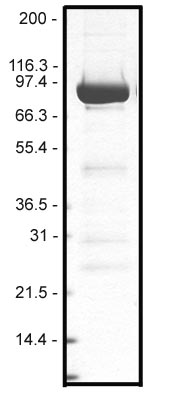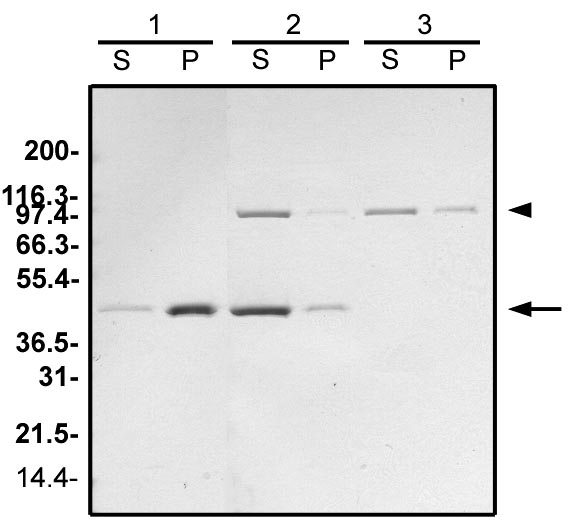Gelsolin protein: Homo sapiens recombinant
Product Uses Include
- Positive control for studying the activity of F-actin severing and capping proteins
- Investigation of the effect of actin binding proteins (ABPs) on actin dynamics
Material
Gelsolin protein has been purified from E.coli expressing recombinant 6xHIS-tagged human gelsolin (plasma isoform). Gelsolin belongs to a class of actin severing and capping proteins called class I F-actin capping proteins. Each of these class I proteins contains a series of conserved 125-150 amino acid repeat motifs. Gelsolin is characterized by the presence of six repeated motifs, three of which are actin binding domains. Gelsolin exerts a powerful regulatory role on actin filament length and its activity can be modulated by Ca2+ levels, pH , polyphosphoinositides and post-translational modification. Plasma gelsolin contains an additional 25aa leader sequence compared to the cytoplasmic isoform. Gelsolin is supplied as a white lyophilized powder. After reconstitution with of nanopure water, the protein will be in the following buffer: 10 mM Tris pH 7.5, 10 mM NaCl, 0.1 mM MgCl2, 1% (w/v) sucrose, and 0.1% (w/v) dextran. The lyophilized protein is stable at 4°C desiccated (<10% humidity) for 6 months.
Purity
Protein purity is determined by scanning densitometry of Coomassie Blue stained protein on a 4-20% gradient polyacrylamide gel. Gelsolin protein is >90% pure (see Figure 1) and runs at approximately 95 kDa (due to leader sequence and 6xHIS-tag).

Figure 1. Gelsolin protein purity determination. A 20 µg sample of HPG5 was separated by electrophoresis in a 4-20% SDS-PAGE system and stained with Coomassie Blue. Protein quantitation was performed using the Precision Red Protein Assay Reagent (Cat.# ADV02).
Biological Activity
The biological activity of gelsolin is determined in an F-actin severing assay. F-actin is incubated with gelsolin and the reaction products are centrifuged at 100,000 x g for 1 h. The proportion of actin in the supernatant (G-actin) versus the pellet (F-actin) is compared to a control reaction without gelsolin. Stringent quality control ensures that gelsolin (2 µg) can solubilize 70-80% of F-actin (5 µg) in five min (see Figure 2)

Figure 2. Gelsolin biological activity determination. Sample 1 - Control F-actin without gelsolin. Sample 2 - F-actin with 2µg of gelsolin. Sample 3 - 2µg of gelsolin only. S = supernatant, P = pellet.
For product Datasheets and MSDSs please click on the PDF links below. For additional information, click on the FAQs tab above or contact our Technical Support department at tservice@cytoskeleton.com
Coming soon! If you have any questions concerning this product, please contact our Technical Service department at tservice@cytoskeleton.com












